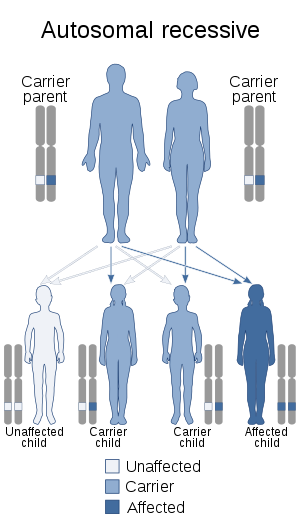Fertile eunuch syndrome
The fertile eunuch syndrome or Pasqualini syndrome is a cause of hypogonadotropic hypogonadism caused by a luteinizing hormone deficiency.[1] It is characterized by hypogonadism with spermatogenesis.[2] Pasqualini and Bur published the first case of eunuchoidism with preserved spermatogenesis in 1950 in la Revista de la Asociación Médica Argentina.[3] The hypoandrogenism with spermatogenesis syndrome included:
| Fertile eunuch syndrome | |
|---|---|
 | |
| Fertile eunuch syndrome is inherited in an autosomal recessive manner. | |
| Specialty | Medical genetics |
(a) eunuchoidism,
(b) testis with normal spermatogenesis and full volume, with mature spermatozoids in a high proportion of seminiferous tubes and undifferentiated and immature Leydig cells
(c) full functional compensation through the administration of chorionic gonadotropin hormone, while hCG is administered
(d) total urinary gonadotrophins within normal limits
(e) this definition implies the normal activity of the pituitary and the absence of congenital malformations in general.
In describing five other similar cases in 1953, Mc Cullagh & al [4][5] coined the term fertile eunuch introducing it in the English literature. Unfortunately, this term is incorrect and should not be employed. Indeed, these patients are not really eunuchs. Moreover, as it will be explained later, they are not usually fertile if not treated.
A first step in the understanding of the physiopathology of Pasqualini syndrome was the absence of Lutheinizing Hormone (LH) in plasma and urine of patients. The second breakthrough was the functional and genetic studies that validated the hypothesis of a functional deficit of LH in these men. Inactivating LH mutations will then also be described in some women. Different groups [6][7][8][9][10] demonstrated in these cases a LH with varying degrees of immunological activity but biologically inactive in most of the patients, due to one or more inactivating mutations in the LHB gene. Finally, the full comprehension of Pasqualini syndrome allowed to reverse the hypoandrogenic phenotype and to restore fertility in these patients through the use of chorionic gonadotropin and the modern in-vitro fertility techniques [11][12]
See also
- Hypogonadism
- Delayed puberty and infertility
- Hypothalamus, pituitary gland, and HPG axis
- GnRH and gonadotropins (FSH and LH)
- Sex hormones (androgens and estrogens)
- Kallmann syndrome and GnRH insensitivity
References
- Valdes-Socin H, Rubio Almanza M, Tomé Fernández-Ladreda M, Debray FG, Bours V, Beckers A. Reproduction, Smell and Neurodevelopmental disorders: Genetic defects in different hypogonadotropic hypogonadal syndromes. Frontiers in Endocrinology 2014;jul 9;5:109. doi: 10.3389/fendo.2014.00109.
- Valdes-Socin H Beckers A. Pasqualini’s syndrome: hypoandrogenism with spermatogenesis. MEDICINA (Buenos Aires) 2015; 75: 53-58.
- Pasqualini RQ, Bur GE. Síndrome hipoandrogénico con gametogénesis conservada. Rev Asoc Méd Argent 1950; 64: 6-10.
- McCullagh EP, Beck JC, Schaffenburg CA: A syndrome of eunuchoidism with spermatogenesis, normal urinary FSH and low or normal ICSH: (“Fertile eunuchs”). J Clin Endocrinol Metab 1953; 13: 49.
- Pasqualini RQ: Hypoandrogenic syndrome with normal spermatogenesis. J Clin Endocrinol Metab 1953; 13: 128.
- Weiss J, Axelrod L, Whitcomb RW, Harris PE, Crowley WF, Jameson JL. Hypogonadism caused by a single amino acid substitution in the beta subunit of luteinizing hormone N Engl J Med. 1992; 326(3):179-83.
- Valdes-Socin H, Salvi R, Daly AF, Gaillard RC, Quatresooz P, Tebeu PM et al. Hypogonadism in a patient with a mutation in the luteinizing hormone beta-subunit gene. N Engl J Med. 2004; 351(25):2619-25.
- Lofrano-Porto A, Barra GB, Giacomini LA, Nascimento PP, Latronico AC, Casulari LA et al. Luteinizing hormone mutation and hypogonadism in men and women. N Engl J Med 2007 357:897–904.
- Achard C, Courtillot C, Lahuna O, Méduri G, Soufir JC, Liere P et al. Normal spermatogenesis in a man with mutant luteinizing hormone. N Engl J Med 2009 361:1856–1863.
- Basciani S, Watanabe M, Mariani S, Passeri M, Persichetti A, Fiore D, Scotto d’Abusco A, Caprio M, Lenzi A, Fabbri A, Gnessi L. Hypogonadism in a Patient with Two Novel Mutations of the Luteinizing Hormone–Subunit Gene Expressed in a Compound Heterozygous Form J. Clin Endocrinol Metab 2012; 97: 3031–3038.
- Valdes-Socin H, Salvi R, Thiry A, Daly AF, Pralong FP, Gaillard R et al. Testicular effects of isolated luteinizing hormone deficiency and reversal by long-term human chorionic gonadotropin treatment. J Clin Endocrinol Metab. 2009;94(1):3-4.
- Valdes-Socin H, Daly AF and Beckers A. Luteinizing Hormone Deficiency: Historical Views and Future Perspectives. Austin Andrology. 2017; 2(1): 1015.
External links
| Classification | |
|---|---|
| External resources |